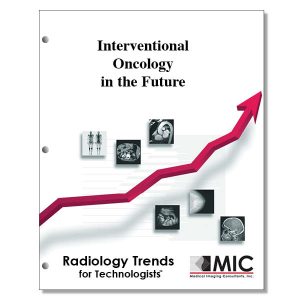

Interventional Oncology in the Future
A subspecialty of interventional radiology, interventional oncology has become integral for supporting patients with cancer. By leveraging emerging technologies, the future of interventional oncology holds enormous potential.
Course ID: Q00783 Category: Radiology Trends for Technologists Modalities: CT, Nuclear Medicine, PET, Radiation Therapy, RRA, Vascular Interventional2.5 |
Satisfaction Guarantee |
$29.00
- Targeted CE
- Outline
- Objectives
Targeted CE per ARRT’s Discipline, Category, and Subcategory classification:
[Note: Discipline-specific Targeted CE credits may be less than the total Category A credits approved for this course.]
Vascular-Interventional Radiography: 0.75
Procedures: 0.75
Nonvascular Procedures: 0.75
Outline
- Introduction
- Precision Interventional Oncology in 2043
- Precision Oncology and Tumor Biomarkers
- Precision Interventional Oncology and Genetic Editing
- Immunotherapy and Locoregional Interventions
- Combination Therapy
- Locoregional Immunotherapy Delivery
- Advances in Imaging and Navigation
- Multimodality Imaging: An Integrated Interventional Oncology Suite
- Multimodality Imaging: Molecular and Functional Imaging
- Three-Dimensional Reconstruction, Image Fusion, and Electromagnetic Navigation
- Virtual and Augmented Reality for Interventional Oncology Training and Procedures
- AI and Deep Learning
- Transarterial Therapies beyond HCC
- Liver-Directed Therapies for Primary and Metastatic Cancer
- Advances in Radioembolization
- Transarterial Therapies beyond the Liver
- The Expanding Role of Ablation
- Ablation beyond the Liver
- Innovating Thermal Ablation
- Nonthermal ablation with Pulsed Electric Field
- Nonthermal Ablation with Histotripsy
- Beyond Tumor-Directed Therapies
- Lymphatic Interventions
- Palliation of Neuropathic and Musculoskeletal Pain
- Biliary Interventions
- Vascular Interventions
- Interventional Oncology Research and Training
- Conclusion
Objectives
Upon completion of this course, students will:
- identify parallels between the emergence of interventional oncology and the evolution of surgical oncology
- discuss why interventional radiologists might frequently be the first cancer specialists to see a patient suspected of having cancer in the future
- determine the applications of precision oncology
- recognize the limitations of tissue biopsy for genetic sequencing
- identify a major technical challenge in gene editing using the CRISPR-Cas9 system
- describe the reasons for the limited efficacy of immune checkpoint inhibitors in some patients
- explain how combination therapy with locoregional interventions and immunotherapy may overcome the limitations of immune checkpoint inhibitors
- recognize potential advantages of percutaneous and transarterial delivery of immune agents compared to systemic administration
- identify commonly combined imaging modalities in modern interventional oncology practices
- recognize a primary challenge of ablation that imaging software aims to address
- describe how PET/CT-guided ablation contributes to interventional oncology
- describe how image fusion in interventional oncology benefits from integrating software and devices
- explain the role of electromagnetic navigation systems in interventional oncology
- define augmented reality in the context of medical imaging
- identify the primary use of virtual reality in interventional oncology
- recognize primary hindrances to the adoption of robotic devices in interventional oncology
- define radiomics in the context of medical imaging
- identify the benefits of transarterial therapy besides tumor treatment
- recognize the cancers being investigated for 90Y radioembolization
- identify a true statement regarding interventional oncology therapies
- describe the role of ablation in cancer treatment
- describe the iterations of ablation devices that might address the challenges of thermal ablation near sensitive structures
- describe irreversible electroporation as a nonthermal ablative modality
- discuss cryoneurolysis as a method for treating neuropathic pain
- identify significant obstacles in treating malignant biliary obstruction
- identify an intervention for noncirrhotic portal hypertension in cancer patients
- recognize cancers treated with chimeric antigen receptor (CAR) T-cell therapy
- identify potential solutions to address the challenge of providing sufficient training volumes in interventional
